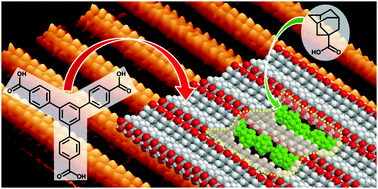Shape controlled assembly of carboxylic acids: formation of a binary monolayer by intercalation into molecular nanotunnels†
Abstract
Binary self-assembled monolayers (SAMs) combining a Y-shaped aromatic carboxylic acid (1,3,5-benzenetribenzoic acid, H3BTB) and a cage-type alicyclic carboxylic acid (adamantane carboxylic acid, AdCA) were investigated by scanning tunneling microscopy (STM), X-ray photoelectron spectroscopy (XPS), and near edge X-ray absorption fine structure (NEXAFS) spectroscopy. The SAMs, prepared by molecular adsorption from solution on Au substrates modified by underpotential deposition of Ag, exhibit a pronounced dependence of their structure on the assembly protocol. Exposing an H3BTB SAM to AdCA, the highly regular row structure of the native H3BTB layer persists and STM imaging does not show signs of AdCA adsorption. This is in striking contrast to the disordered arrangements of H3BTB and the presence of AdCA employing the inverted adsorption sequence or coadsorption of the two molecules. However, spectroscopic analysis of the H3BTB SAM exposed to AdCA reveals the presence also of the latter, suggesting that the AdCA molecules are hidden in the nanotunnels of the H3BTB monolayer. Direct evidence for the intercalation of AdCA is obtained by STM manipulation experiments which lay bare areas of AdCA molecules upon local removal of H3BTB. Surprisingly, these are densely packed and arranged into a highly ordered monolayer. Formation of such a compact AdCA layer is explained by expulsion of AdCA from the H3BTB nanotunnels of the surrounding intact mixed SAM, driven by release of stress in the nanotunnels built up when AdCA is intercalated.



 Please wait while we load your content...
Please wait while we load your content...